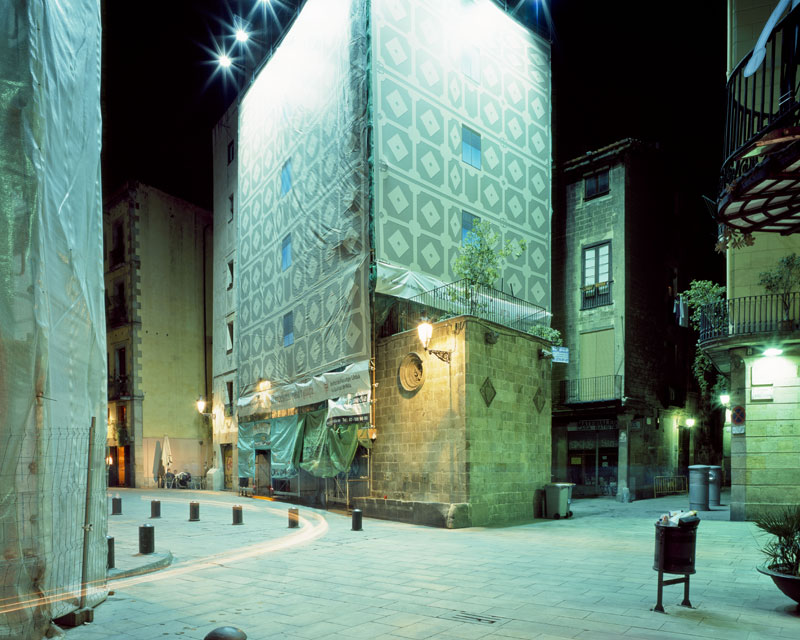William Mokrynski, Toronto, Canada
William Mokrynski is a Canadian photo-based media artist, based in London, UK. He studied new media and photography at the Ontario College of Art and Design in Toronto, Canada, and has an MFA in photography from the University of Edinburgh, UK. In his recent work, Mokrynski uses the camera to explore architectural interventions found within the urban and natural landscape; structures and objects which provide for societal needs of convenience, security, and rejuvenation. Past and ongoing projects utilize pinhole photography as a mechanism for the fabrication of memory-scapes; oneiric visual stanzas triggered by the juncture of experience and the subconscious while traversing a landscape. In addition to photography, Mokrynski works with sculpture, paint, electronic media, and video. His work has been exhibited in North America, Europe, and North Africa.
Nylon Chrysalis
Late one evening back in 1989, I stumbled upon a strange assemblage of wooden planks crisscrossing the façade of a small lot situated between two vacant historic buildings on one of the main streets of my hometown of Toronto. Within the shadows of the city’s glow, it appeared as an organic growth of raw lumber that spanned the lot and intertwined with the neighbouring buildings. I initially thought this was a complex scaffolding structure for a construction site that was in a state of assembly or disassembly. Stepping into the site I realized the structure was not part of a construction site, but was the finished construction itself. What I had discovered was a temporary installation by Japanese artist Tadashi Kawamata. Kawamata’s works, often referred to as “displacements”, are chaotic improvisational architectural growths of found lumber, and construction debris. They are purposeful interventions on the streetscape that disrupt the rhythm of the urban landscape. I create something that is in a different order. Because the city is based on a very tight structure, the artist must always make something to resist it. 1 This experience with Kawamata’s Toronto Project, planted a seed in my mind and forever altered the way I interact with the urban landscape; particularly how I view interventions such as scaffolding assemblages found at construction and renovation sites. These are no longer blights on the landscape, or obstructing structures secondary to the buildings they are affixed to. These are interesting architectural pieces in themselves, who’s appearance is often a refreshing disruption of the everyday streetscape. Like a butterfly’s woven chrysalis, these structures protect and hide a transformation taking place. These structures become most interesting once workers have left and the sun has set. In the darkened environment they become quiet and still; frozen until the daylight brings the worker’s return. Abandoned, the structure becomes suspended in time, leaving few clues to its temporal existence. Is the work ongoing? Has the site been abandoned? Is it permanent? How much longer will it be there? Impossible to tell. During these quiet hours, the scaffolding transforms from utilitarian to ornamental. Colour casts and shadows from the surrounding city’s illumination flatten and blend the structure with the host building. The draped tarps and netting reflect the incidental light while revealing shadows and silhouettes of it’s underlying skeletal structure. The chrysalis is alien, but somehow right.
1 Tadashi Kawamata, “Kawamata: An Interview,” Interview by Linda Genereux, Kawamata: Toronto Project 1989 (Toronto: Mercer Union: a centre for contemporary visual art, 1989), p31

Corn Dogs and Candy Apples
*We all have experiences that occur year after year - birthdays, New Year’s celebrations, family vacations... Over time these repeated events blend together and form an interwoven memory ; a mental montage. *
Among my earliest childhood memories are vivid impressions of annual visits to amusement parks - the colours, the lights, the bustle of people. One particular amusement park, a part of the Canadian National Exhibition, forms a large part of this early memory. (The Canadian National Exhibition takes place every year during the last two weeks of August in the city of Toronto and is a marker of the end of summer.) My recollection of this annual event is a blend of memories from throughout my life; a collage of impressions, sights, sounds.
Corn Dogs and Candy Apples visually explores this memory montage.
Overlapping junctures of time and recollection that form a mental montage of past experience. I attempt to capture recollections by reconstructing views and attractions as I remember them. The result is a ethereal landscape; a place closer to our dreams and memories than reality.
Working with a pinhole camera, I assemble views using a technique I call in-camera montage. This approach involves assembling pieces of a scene along a length of film, by letting overlapping exposures blend into each other, and thereby creating a fragmented reformation of the scene. Time is condensed from several moments into a single image. A filmstrip that can allude to a narrative when read along the exposures. Pinhole cameras require long exposures, capturing the passage of time rather than an instant. Motion within an exposure becomes a smear. People are transformed into silhouettes or impressions, simulating my memory of the crowds attending. The pinhole camera allows me to work quickly, adding elements without the need to compose through a viewfinder or focus a lens as these elements do not exist on pinhole cameras. Scenes are constructed from multiple viewpoints and locations as I absorb the atmosphere of the environment. Some images are assembled from views spanning a 30 minute or more stroll.









